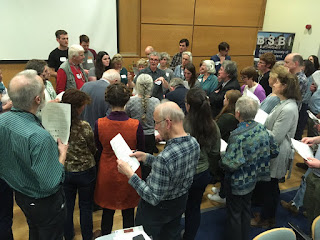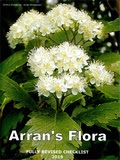 |
Getting ready to get to grips with Callitriche ID
Image: F. O'Neill |
In the first part of Erin's report on this year's Irish Spring Conference, we left her heading off for lunch following the morning's talks, having just heard Maria's announcement about the forthcoming Aquatic
Plants Project. Erin picks up the story again:
"Following on with the aquatic theme, I
opted for the workshop on Callitriche/water-starworts over the Spring Blossoms tour.
Callitriche is a difficult genus, occurring in a wide variety of habitats
terrestrial, aquatic and semi amphibious with variable vegetative features as a
result. Here to help demystify Callitriche was Lynda Weekes from IT Tralee. In
order to appeal to the beginners and intermediates in the audience, Lynda
focused on a simplified list of features of leaves and fruit suitable for use
in the field.
 |
Callitriche herbarium specimens
Image: E. Griffin |
"There are seven known Callitriche species in Ireland, C. truncata,
C. stagnalis, C. platycarpa, C. palustris, C. obtusangula, C. hermaphroditica
and C. brutia. Lynda pointed out that although leaves are a good indicator of
species, they are quite variable and can change with habitat/water level. For
example, C. obtusangula has leaves rhomboidal in shape in still water and
linear in flowing water. In this case, fruits (and pollen for subspecies) are
needed for positive identification. For C. obtusangula the fruit would
noticeably have no keel, the grooves of the fruit hardly present to almost flat
and when ripe the fruit would be as long as it is wide. After Lynda’s
presentation, members took a closer look at Callitriche using herbarium specimens kindly provided by the National Botanic Gardens.
 |
David starts his quiz
Image: O. Duffy |
"Next up was quiz time with David McNeill! With
rounds of 'guess the plant from its distribution' or three seemingly unrelated
pictures, to naming prominent BSBI members, David had the entire conference
putting their heads together. A nice break-up from the talks and a good
opportunity to get to know your team members.
"Flash talks was everything I hoped it would
be: a diverse range of topics, cut into bite size chunks and delivered in short
bursts of 5-10 minutes. Over the course of 45 mins I learned about an up and
coming book, a missing plant rediscovered and an entirely novel use for Google street
view.
"Up first was Roger Goodwillie (County Recorder for Kilkenny) offering a rare glimpse of the winter Burren, a
landscape famed for its flowering season. Roger took the time to walk us
through the winter Burren and point out the plants and rare sights we don’t see
when the Burren is at full bloom. Some notable mentions are Sedum acre (biting
stonecrop), Sedum album (white stonecrop), trees covered in Ivy and liverwort,
and the important grazers such as horses and cattle.
 |
Daniel starts his flash talk about black poplars
Image: C. Heardman |
"Daniel Buckley (Conservation Ranger with
the National Parks and Wildlife Service) maps on Ireland’s rarest tree, the
black poplar. Through the use of Google street view, an unlikely tool, Daniel
was able to locate these distinctly shaped trees. This method allowed him to
quickly find and later identify the species onsite. Daniel was able to improve
upon the existing studies on black poplar which were vague and lacked resolution
and even confirmed the tree's presence in Kerry. He also propagated a
representative sample of black poplar in his garden in the name of
conservation.
John Conaghan (County Recorder for
west Galway) detailed his rediscovery of Silene acaulis (moss campion), a rare
montane species that has been missing for the past 120 years. First recorded in
1839 by Charles Moore and recorded last at Dunaff head in East Donegal, growing in a
place ‘where not many people would care to linger over’. Enlisting the help of
the local County Recorders, Mairéad Crawford and Oisín Duffy, John was
able to rediscover S. acaulis on the east side of Dunaff head.
 |
Mairead captured Oisin & John hunting toothworts
in the Botanic Gardens during the lunch-break!
Image: M. Crawford |
"Up next, Fionnuala O’Neill (BEC
Consultants) gave an update on the conservation status of six rare vascular
plants as part of a rare plant monitoring survey. The six plants mentioned were
Trichomanes speciosum (Killarney fern), Diphasiastrum alpinum (Alpine
clubmoss), Saxifraga hirculus (marsh saxifrage), Lycopodium clavatum
(Staghorn clubmoss), Lycopodium inundatum (marsh clubmoss) and Huperzia selago
(Fir clubmoss). The clubmoss group have suffered loss of habitat with
agricultural improvement and drainage, the most threatened clubmoss being the
marsh clubmoss due to its lowland habitat. The Killarney fern is of least
concern because all its attributes are in good condition and the marsh
saxifrage is near threatened because of habitat loss.
"Joe Caffrey (Inland Fisheries Ireland)
talked about his up and coming book ‘Photographic guide to aquatic and riparian
plants in Ireland’. The book, aimed at the general botanist, has documented over 250
species. A sneak peek at the pages which are mainly photos, and we could see a
concise profile of habitat, useful diagnostic features, distribution, flowering
period, ecology and even the species name in Irish. A useful aid for any
botanists wishing to become more familiar with aquatic species.
 |
Paul's dead-nettle workshop was very popular!
Image: O. Duggan |
"‘20 sites, 20 species’ by Mark O’Callaghan
(OPW and NPWS Guide at multiple sites) discussed the conservation work in
nature reserves across Ireland. Unfortunately, I can’t list the full 20 but
some notable mentions were Salvelinus alpinus (arctic char) in Glenveagh to the Cygnus
cygnus (whooper swan) at Coolepark, Filipendula ulmaria (meadowsweet) in the Burren
and the Lagopus scotica (red grouse) in the Wicklow mountains. Mark emphasised
the importance of the reserves to these species, while playing audio of the
bird calls. A first at a BSBI conference!
"Finally, Noeleen Smyth (Botanist at the
National Botanic Gardens) told the story of frankincense, a fascinating desert
plant that has been heavily traded on the Arabian Peninsula for more than 6000
years, now a threatened species with poor regeneration. Typically used in
embalming and religious ceremonies, frankincense became widespread through the
silk trade and was once worth as much as gold in Rome. The trade has become
largely uncontrolled and exploitative but thankfully the plant is soon to be
listed within CITES. Noeleen passed some of the aromatic resin around the
auditorium.
 |
The master in action: Paul de-mystifying dead-nettles
Image: C. Heardman |
"This was followed by a hands-on workshop
with Paul Green (Country Recorder for Co. Wexford) on dead-nettles or a free
slot to explore the gardens. Paul provided a key to dead-nettles and yellow
archangels. The main dead-nettles in Ireland are Lamium album (White
dead-nettle), Lamium maculatum (spotted dead-nettle), Lamium amplexicaule (Henbit
dead-nettle), Lamium confertum (Northern Dead-nettle), Lamium purpureum (red
dead-nettle) and Lamium hybridum (cut-leaved dead-nettle). The most difficult of
these to differentiate are the cut-leaved, red and northern dead-nettle for
their similar reddish-purple flower. Training your eye to the finer details is
essential as the length of the calyx tube or slight differences between leaf
veins can be all that separates you from proper identification. I really
appreciated having an expert on-site to talk through the key and gained a
greater appreciation for these workshops.
 |
Happy botanists after a great conference!
Oonagh Duggan (Assistant Head of Advocacy
& Policy for BirdWatch Ireland)
takes a selfie with Ralph Sheppard,
County Recorder for West Donegal:
they are both birders as well as botanists! |
"To round off the day Maria Long announced
the quiz results which crowned the team ‘The starworts’ (but with a star!) as
the winners (not to be confused with the starworts without a star, which was my
group!). Maria gave a special thanks to all the guest speakers and all who
attended. The conference concluded with networking, food and drinks in the
nearby pub.
"I really enjoyed attending my first BSBI
conference. There was an aquatic theme throughout the event. It was really
great to see the BSBI address this problem of under-recording and move forward with
solutions. This is an excellent event for all levels of botanist, and as a newcomer
I found the BSBI community very welcoming. The event allows plenty of time for
networking and attracts a really great crowd. I am already looking forward to
next year’s line-up. If you missed the conference, you can find many of the presentations on the conference webpage."
Many thanks to Erin for this report - we're delighted that she enjoyed her first BSBI Irish Conference!
 This blogpost should have gone out hours ago but I made the mistake of opening up my advance copy of the latest issue of BSBI News - just so I could find out what was in there and report to all of you - and suddenly it's nearly midnight!
This blogpost should have gone out hours ago but I made the mistake of opening up my advance copy of the latest issue of BSBI News - just so I could find out what was in there and report to all of you - and suddenly it's nearly midnight! 





















